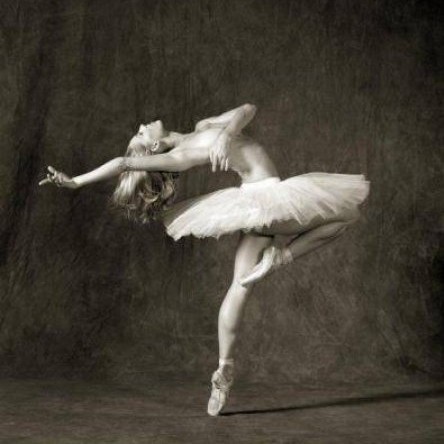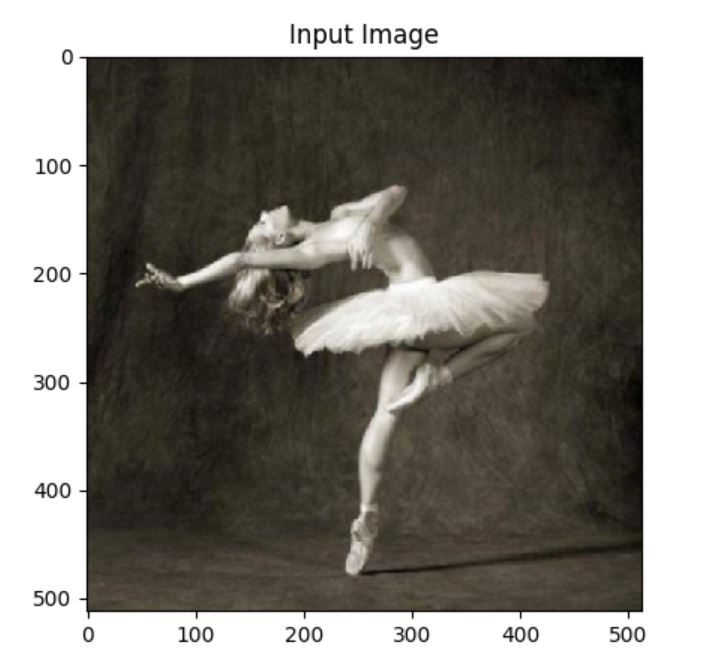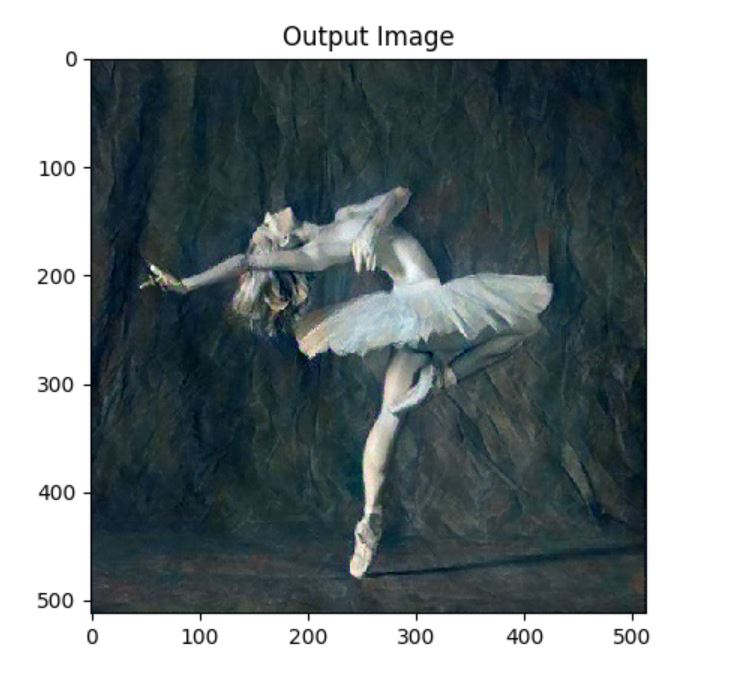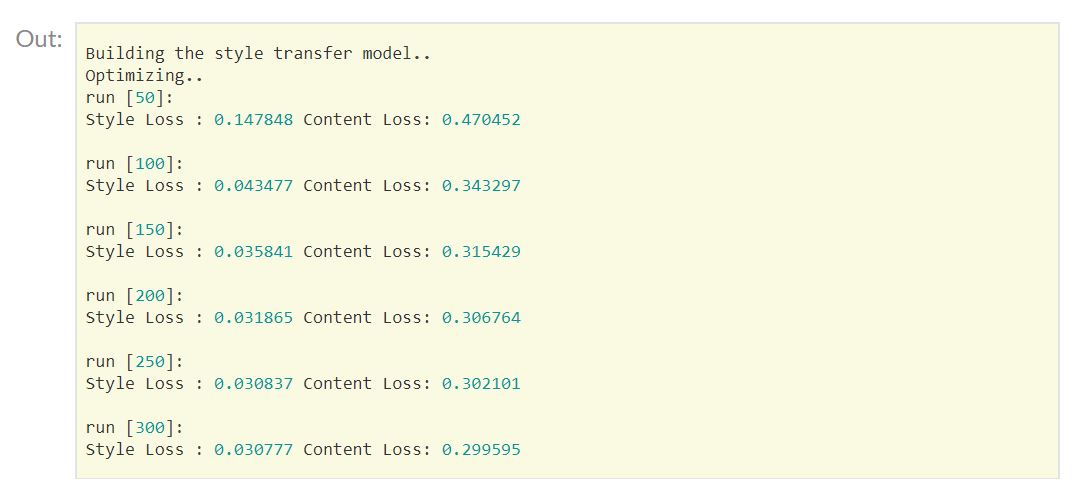基於PyTorch的深度學習入門教程(八)——影象風格遷移
阿新 • • 發佈:2019-01-08
前言
本文介紹怎樣執行Neural-Style演算法。Neural-Style或者叫做Neural-Transfer,將一個內容影象和一個風格影象作為輸入,返回一個按照所選擇的風格影象加工的內容影象。
原理是非常簡單的:我們定義兩個距離,一個用於內容(Dc),另一個用於(Ds)。Dc測量兩個影象的內容有多像,Ds測量兩個影象的風格有多像。然後我們採用一個新影象(例如一個噪聲影象),對它進行變化,同時最小化與內容影象的距離和與風格影象的距離。
PyTorch中的實現
Packages
from __future__ import print_function
import torch
import Cuda
use_cuda = torch.cuda.is_available()
dtype = torch.cuda.FloatTensor Load images
將下面兩個影象picasso.jpg和dancing.jpg下載下來,放到images資料夾中。Images資料夾要在程式執行的當前目錄。
# desired size of the output image
imsize = 512 if use_cuda else 128 # use small size if no gpu
loader = transforms.Compose([
transforms.Scale(imsize), # scale imported image Display images
unloader = transforms.ToPILImage() # reconvert into PIL image
plt.ion()
def imshow(tensor, title=None):
image = tensor.clone().cpu() # we clone the tensor to not do changes on it
image = image.view(3, imsize, imsize) # remove the fake batch dimension
image = unloader(image)
plt.imshow(image)
if title is not None:
plt.title(title)
plt.pause(0.001) # pause a bit so that plots are updated
plt.figure()
imshow(style_img.data, title='Style Image')
plt.figure()
imshow(content_img.data, title='Content Image')執行效果:
Content loss
class ContentLoss(nn.Module):
def __init__(self, target, weight):
super(ContentLoss, self).__init__()
# we 'detach' the target content from the tree used
self.target = target.detach() * weight
# to dynamically compute the gradient: this is a stated value,
# not a variable. Otherwise the forward method of the criterion
# will throw an error.
self.weight = weight
self.criterion = nn.MSELoss()
def forward(self, input):
self.loss = self.criterion(input * self.weight, self.target)
self.output = input
return self.output
def backward(self, retain_graph=True):
self.loss.backward(retain_graph=retain_graph)
return self.lossStyle loss
class GramMatrix(nn.Module):
def forward(self, input):
a, b, c, d = input.size() # a=batch size(=1)
# b=number of feature maps
# (c,d)=dimensions of a f. map (N=c*d)
features = input.view(a * b, c * d) # resise F_XL into \hat F_XL
G = torch.mm(features, features.t()) # compute the gram product
# we 'normalize' the values of the gram matrix
# by dividing by the number of element in each feature maps.
return G.div(a * b * c * d)class StyleLoss(nn.Module):
def __init__(self, target, weight):
super(StyleLoss, self).__init__()
self.target = target.detach() * weight
self.weight = weight
self.gram = GramMatrix()
self.criterion = nn.MSELoss()
def forward(self, input):
self.output = input.clone()
self.G = self.gram(input)
self.G.mul_(self.weight)
self.loss = self.criterion(self.G, self.target)
return self.output
def backward(self, retain_graph=True):
self.loss.backward(retain_graph=retain_graph)
return self.lossLoad the neural network
cnn = models.vgg19(pretrained=True).features
# move it to the GPU if possible:
if use_cuda:
cnn = cnn.cuda()# desired depth layers to compute style/content losses :
content_layers_default = ['conv_4']
style_layers_default = ['conv_1', 'conv_2', 'conv_3', 'conv_4', 'conv_5']
def get_style_model_and_losses(cnn, style_img, content_img,
style_weight=1000, content_weight=1,
content_layers=content_layers_default,
style_layers=style_layers_default):
cnn = copy.deepcopy(cnn)
# just in order to have an iterable access to or list of content/syle
# losses
content_losses = []
style_losses = []
model = nn.Sequential() # the new Sequential module network
gram = GramMatrix() # we need a gram module in order to compute style targets
# move these modules to the GPU if possible:
if use_cuda:
model = model.cuda()
gram = gram.cuda()
i = 1
for layer in list(cnn):
if isinstance(layer, nn.Conv2d):
name = "conv_" + str(i)
model.add_module(name, layer)
if name in content_layers:
# add content loss:
target = model(content_img).clone()
content_loss = ContentLoss(target, content_weight)
model.add_module("content_loss_" + str(i), content_loss)
content_losses.append(content_loss)
if name in style_layers:
# add style loss:
target_feature = model(style_img).clone()
target_feature_gram = gram(target_feature)
style_loss = StyleLoss(target_feature_gram, style_weight)
model.add_module("style_loss_" + str(i), style_loss)
style_losses.append(style_loss)
if isinstance(layer, nn.ReLU):
name = "relu_" + str(i)
model.add_module(name, layer)
if name in content_layers:
# add content loss:
target = model(content_img).clone()
content_loss = ContentLoss(target, content_weight)
model.add_module("content_loss_" + str(i), content_loss)
content_losses.append(content_loss)
if name in style_layers:
# add style loss:
target_feature = model(style_img).clone()
target_feature_gram = gram(target_feature)
style_loss = StyleLoss(target_feature_gram, style_weight)
model.add_module("style_loss_" + str(i), style_loss)
style_losses.append(style_loss)
i += 1
if isinstance(layer, nn.MaxPool2d):
name = "pool_" + str(i)
model.add_module(name, layer) # ***
return model, style_losses, content_lossesInput image
input_img = content_img.clone()
# if you want to use a white noise instead uncomment the below line:
# input_img = Variable(torch.randn(content_img.data.size())).type(dtype)
# add the original input image to the figure:
plt.figure()
imshow(input_img.data, title='Input Image')執行效果:
Gradient descent
def get_input_param_optimizer(input_img):
# this line to show that input is a parameter that requires a gradient
input_param = nn.Parameter(input_img.data)
optimizer = optim.LBFGS([input_param])
return input_param, optimizer定義演算法並執行
def run_style_transfer(cnn, content_img, style_img, input_img, num_steps=300,
style_weight=1000, content_weight=1):
"""Run the style transfer."""
print('Building the style transfer model..')
model, style_losses, content_losses = get_style_model_and_losses(cnn,
style_img, content_img, style_weight, content_weight)
input_param, optimizer = get_input_param_optimizer(input_img)
print('Optimizing..')
run = [0]
while run[0] <= num_steps:
def closure():
# correct the values of updated input image
input_param.data.clamp_(0, 1)
optimizer.zero_grad()
model(input_param)
style_score = 0
content_score = 0
for sl in style_losses:
style_score += sl.backward()
for cl in content_losses:
content_score += cl.backward()
run[0] += 1
if run[0] % 50 == 0:
print("run {}:".format(run))
print('Style Loss : {:4f} Content Loss: {:4f}'.format(
style_score.data[0], content_score.data[0]))
print()
return style_score + content_score
optimizer.step(closure)
# a last correction...
input_param.data.clamp_(0, 1)
return input_param.dataoutput = run_style_transfer(cnn, content_img, style_img, input_img)
plt.figure()
imshow(output, title='Output Image')
# sphinx_gallery_thumbnail_number = 4
plt.ioff()
plt.show()執行結果:






